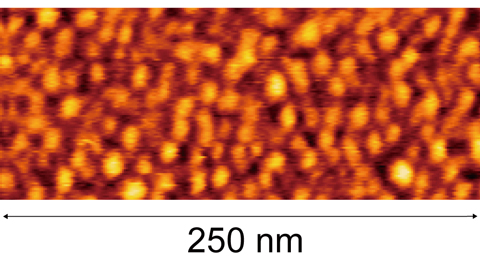A research team comprising Drs. Takaaki Mano, Yoshiki Sakuma and Masafumi Jo from the Photonic Materials Unit of the National Institute for Materials Science is involved in the development of a sophisticated self-assembling technology known as droplet epitaxy for semiconductor quantum dots.
 Atomic force microscope (AFM) image of ultra-high surface density quantum dots formed by reducing the amount of gallium irradiation to 3 monolayer at a growth temperature of 30°C. An ultra-high surface density of 7.3 x 1011/cm2 was achieved.
Atomic force microscope (AFM) image of ultra-high surface density quantum dots formed by reducing the amount of gallium irradiation to 3 monolayer at a growth temperature of 30°C. An ultra-high surface density of 7.3 x 1011/cm2 was achieved.
The researchers have successfully developed an advanced self-assembling technology to form quantum dots with a record surface density. Moreover, the self-assembled quantum dot groups emitted powerful photoluminescence, which indicates that the devised technology can also be used to obtain superior crystal quality.
In this technology, utilization of a high-index-surface substrate, gallium droplet creation and crystallization at near-room temperature and the droplet coalescence suppression by increasing the supplied gallium quantity were introduced in the formation of gallium arsenide quantum dots by droplet epitaxy. Thus, the researchers successfully created self-assembled gallium arsenide quantum dots with unprecedented surface density of 7.3x1011/cm2 in a lattice-matched system. They have also found that it is possible to restore defects formed during crystallization at near-room temperature by applying skill in the heat treatment technique for the crystallized quantum dots, thus enabling the quantum dots to demonstrate powerful photoluminescence.
Droplet epitaxy is the only technique that facilitates quantum dot self-assembly in lattice-matched systems and provides the benefit of tightly stacking more number of superior quality quantum dot layers while retaining high crystallinity. Hence, tight packing of the ultra-high density in-plane quantum dots synthesized in this research will facilitate the formation of extremely high-volumetric-density quantum dot materials, which are impossible with the traditional technology. This research paves the way to develop superior performance quantum dot-based electronic and optical devices.
The study findings have been reported in the online version of Applied Physics Letters.